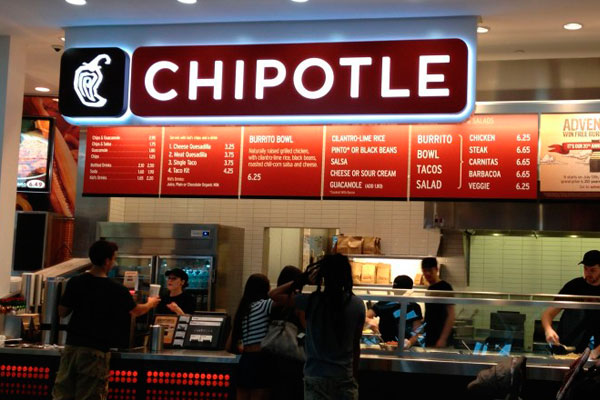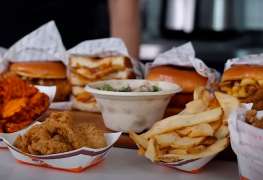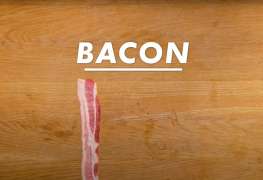 Chipotle set out to challenge fast food trends and be better than the competition—in the end, they launched a new industry. Here's how they rose to the top of the fast-food chain.
Chipotle set out to challenge fast food trends and be better than the competition—in the end, they launched a new industry. Here's how they rose to the top of the fast-food chain.In 1991, Steve Ells couldn’t afford to eat regularly at the legendary Stars restaurant where he was working as a $12-an-hour line cook. Instead, he was more frequently found gorging himself on giant burritos at a taquería in San Francisco’s Mission District called Zona Rosa. It was there, over a carnitas burrito, that Ells had the insight that would change his life—and American fast food—forever.
Ells looked up from his table at the long line of people waiting to order their food and the small group of workers behind the counter preparing the rice, beans, pork, and guacamole. "I remember jotting down on a napkin at that moment how many people were going through the line, how quickly," he told the Rocky Mountain News in 2006, "and I thought, they probably have this much in sales, the food costs might be X—a good little business."
As a trained chef and graduate of the Culinary Institute of America, Ells was intrigued by something else about Zona Rosa. Its food was produced fast and inexpensively, but the quality and the flavor weren’t compromised in the way that typical fast food fare is. He returned to his hometown of Boulder, Colorado, and there in 1993 he opened the first in a chain of Chipotle Mexican Grills.
There are now over 1,400 Chipotle locations in 43 states, and the chain reportedly made a 25% profit margin on $2 billion in sales in 2011.
Chipotle began a trend in restaurants that the industry has dubbed "fast casual," which offers a more upscale dining environment and food quality, along with higher prices, but in the familiar, convenient limited service format of fast food. "When I started Chipotle, I didn’t know the fast-food rules," Ells explained years later. "People told us the food was too expensive and the menu was too limited. Neither turned out to be true."
By either ignoring or directly challenging all the dominant trends in its industry, Chipotle quickly became a great brand. Now Chipotle has become the trend-setter in the category, and trade publications feature headlines such as, "Who Will Be the Chipotle of Pizza?" Wendy’s and Taco Bell are just two of the most prominent fast food players investing in new store designs that look shockingly similar to that of Chipotle. The Wall Street Journal dubbed Ells the "Fast Food Revolutionary," and Esquire crowned him America’s most admired CEO.
A CHALLENGER BRAND THAT CHALLENGES EVERYTHING
The common wisdom in the fast food industry has always been that you grind out your
profits through reduced prices, expanded menus, and raised operational efficiencies. At the time of Chipotle’s founding, Taco Bell—the putative head-on competitor to Chipotle in the Mexican food category—was turning heads in the industry with its enormously successful penny-pinching "59–79–99" value menu.
But Ells grew Chipotle by going in the opposite direction. He determined that Chipotle
could introduce a higher quality of Mexican fare to a broader audience by defining a different value equation for fast food. All the food would be freshly prepared. The ingredients would be top quality. And the restaurants themselves would be beautiful, all wood and metal, offering a dining experience several notches above fast-food Formica counters and fluorescent lighting. Efficiencies in the fast food industry depend largely upon limiting spoilage and minimizing labor costs by cooking frozen meat patties and french fries, but Chipotle restaurants don’t even have freezers. All of Chipotle’s ingredients are delivered fresh. After the company bought hundreds of labor-saving onion-slicing machines, Ells ordered that onions go back to being hand-cut because he felt that made them taste better. Machine-cutting had left the onions a little dried out.
Another standard fast-food practice is to pay employees as little as possible, while Chipotle’s practice is to pay more, but to dismiss employees who lack energy or are otherwise mediocre performers (One industry observer marveled, "Who ever heard of a fast-food restaurant firing someone for being mediocre?").
Despite its higher wages, however, Chipotle still manages to spend more on ingredients than it does on payroll, the exact reverse of the fast food formula for success. In the years when other restaurants of all kinds were cutting prices in a race to bottom, Chipotle either held fast or raised prices. For instance, when Ells was unhappy with the taste of his shredded pork burrito, he went out and sourced a higher grade of pork and raised the burrito’s price by a dollar, and sales of the product reportedly doubled to a full 8% of company revenue.
In the course of Chipotle’s rise from one store to over 1,400, there have been countless temptations for the company to stray from its distinct course and lapse into following trends. Much of Chipotle’s early growth had been financed by a large investment from McDonald’s Corporation, and executives there failed in their efforts to get Chipotle to offer low-risk high-profit menu items such as cookies and coffee. "They probably did give me grief," Ells modestly explained to Time magazine in 2012. "We wouldn’t do [cookies and coffee] better than anyone else. And I don’t want anything to be part of Chipotle that wouldn’t be the very best."
McDonald's sold its stake in Chipotle in 2006, and since then, Chipotle has moved farther and farther away from the typical fast food way of doing business. Ells’s latest obsession is the issue of sustainability. Chipotle is now the largest buyer of higher-priced pork, beef, and chicken from animals that have been naturally fed and humanely raised outside of the factory-farming system, which provides inexpensive commodity meats to the rest of the food industry. Produce served at Chipotle is also locally raised if possible (lettuce served in January on the East Coast still comes from California). What Chipotle has learned is that customers notice the difference in flavor from natural meats and fresh vegetables grown "with integrity," as the chain’s tagline states—and they’re willing to pay extra for it.








Leave a comment